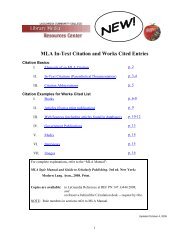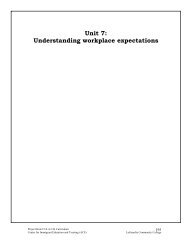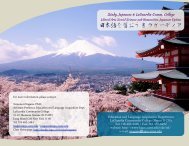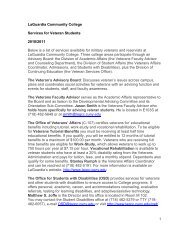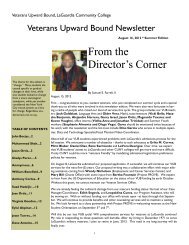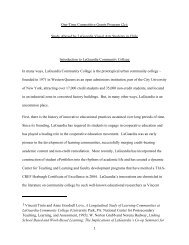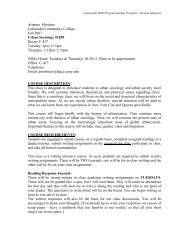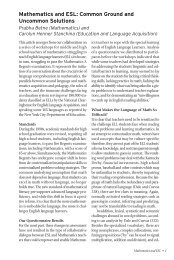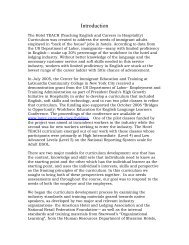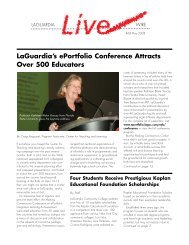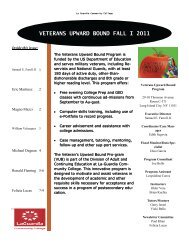Unit 3: Communicating with the Guests - Florida Literacy Coalition
Unit 3: Communicating with the Guests - Florida Literacy Coalition
Unit 3: Communicating with the Guests - Florida Literacy Coalition
Create successful ePaper yourself
Turn your PDF publications into a flip-book with our unique Google optimized e-Paper software.
<strong>Unit</strong> 3:<br />
<strong>Communicating</strong> <strong>with</strong> <strong>the</strong> <strong>Guests</strong><br />
Project Hotel T.E.A.C.H. Curriculum<br />
Center for Immigrant Education and Training (ACE)<br />
65<br />
LaGuardia Community College
Hotel TEACH Lesson Plan<br />
<strong>Unit</strong> 3, Lesson 1<br />
Career Counseling: Elements of Listening Actively<br />
Objectives<br />
Sts will learn active listening strategies to use in <strong>the</strong>ir communication.<br />
EFF Skill Sets<br />
Industry Skill Sets<br />
Cooperate <strong>with</strong> O<strong>the</strong>rs: Seek input from<br />
o<strong>the</strong>rs in order to understand <strong>the</strong>ir actions<br />
and reactions.<br />
Listen Actively: Clarify purpose for<br />
listening and use listening strategies<br />
appropriate to that purpose.<br />
Communicate <strong>with</strong> O<strong>the</strong>rs<br />
Exceed Customer Expectations<br />
Activity 1: Introduce Active Listening Skills<br />
T shows video clip from “Workforce Essential Skills — Communication<br />
Skills #9.” Show section 3:00–4:15. T elicits active listening skills from<br />
<strong>the</strong> Sts <strong>with</strong> <strong>the</strong> following questions:<br />
Note how <strong>the</strong> woman listens to her manager as he trains her to work as a<br />
waitress.<br />
In what ways did she listen?<br />
In what ways did she not?<br />
What could she have done better?<br />
(T writes responses on <strong>the</strong> board.)<br />
T shows ano<strong>the</strong>r video clip, section 17:06–18:06. Ask Sts to note down<br />
what advice <strong>the</strong> woman’s co-worker gives her to improve her listening<br />
skills. When <strong>the</strong> clip is finished, elicit from Sts what <strong>the</strong>y heard <strong>the</strong> coworker<br />
tell <strong>the</strong> waitress about listening. T can also prompt responses<br />
<strong>with</strong> questions such as:<br />
How do you know when people are listening to you? How can you tell? What are<br />
<strong>the</strong> nonverbal cues? How does it feel not to be listened to?<br />
Write St responses on <strong>the</strong> board, and give Sts handout <strong>with</strong> active<br />
listening guidelines. T <strong>the</strong>n asks Sts to read guidelines aloud. Review<br />
any questions about vocabulary or content that come up. T can ask Sts<br />
if <strong>the</strong>y agree <strong>with</strong> <strong>the</strong> statements and if <strong>the</strong>y recommend a guideline that<br />
is not on <strong>the</strong> list. T writes responses on <strong>the</strong> board.<br />
Activity 2: Practice Active Listening Skills<br />
Divide <strong>the</strong> class into groups of three. There will be three roles in each<br />
group: speaker, listener and observer. Each St will have an opportunity<br />
to practice one of <strong>the</strong>se roles. T can suggest that <strong>the</strong> person whose name<br />
Project Hotel T.E.A.C.H. Curriculum<br />
Center for Immigrant Education and Training (ACE)<br />
66<br />
LaGuardia Community College
egins closest to <strong>the</strong> letter “A” be <strong>the</strong> speaker; <strong>the</strong> second closest can be<br />
<strong>the</strong> listener, and <strong>the</strong> third closest is <strong>the</strong> observer.<br />
Direct <strong>the</strong> speaker to talk about something that is important to<br />
him/her — job, family, an important decision or a topic of importance —<br />
for three to four minutes. Encourage <strong>the</strong> Sts to talk about something<br />
<strong>the</strong>y really care about in order to make <strong>the</strong> practice more helpful to<br />
<strong>the</strong>m. If <strong>the</strong> St runs out of <strong>the</strong> allotted time in <strong>the</strong> midst of discussing<br />
something important, suggest that <strong>the</strong> St make an agreement <strong>with</strong> <strong>the</strong><br />
person listening to continue later, after class or during a break.<br />
Instruct <strong>the</strong> listener to practice <strong>the</strong> active listening skills reviewed in <strong>the</strong><br />
handout: eye contact, body language, silence and probing questions.<br />
Listeners will concentrate on following <strong>the</strong> speaker’s conversation and<br />
understanding what he/she is saying. Remind listeners to focus on what<br />
is being said and not think about what <strong>the</strong>y will say when it is <strong>the</strong>ir turn.<br />
The observer’s role is to study <strong>the</strong> communication between <strong>the</strong> listener<br />
and <strong>the</strong> speaker. Observe <strong>the</strong>ir interaction, and note <strong>the</strong> use of active<br />
listening skills by <strong>the</strong> listener. Instruct observers to look for nonverbal<br />
cues by <strong>the</strong> speaker that demonstrate his/her feelings. The observer can<br />
also time <strong>the</strong> conversation, announcing “Stop!” when <strong>the</strong> time is up.<br />
Tell Sts that this exercise is not a competition or judgment; it is merely<br />
an exercise to sharpen <strong>the</strong>ir listening skills. Tell Sts to relax and flow<br />
<strong>with</strong> <strong>the</strong> conversation.<br />
When <strong>the</strong> speaker finishes, <strong>the</strong> group will discuss <strong>the</strong> experience. The<br />
listener will discuss his/her experience using active listening:<br />
What was comfortable? Difficult? Did you stay <strong>with</strong> <strong>the</strong> speaker or mentally go<br />
someplace else?<br />
Then <strong>the</strong> speaker will share his/her feelings about being listened to:<br />
Did he/she feel listened to? Why or why not? Were <strong>the</strong>re any distractions?<br />
The observer will <strong>the</strong>n share observations: body language, eye contact,<br />
whe<strong>the</strong>r questions were appropriate or not. This sharing process should<br />
take about four minutes. T can time this and announce to <strong>the</strong> class<br />
when it is time to switch roles. T can also write <strong>the</strong> questions on <strong>the</strong><br />
board to guide <strong>the</strong> Sts in <strong>the</strong>ir conversation.<br />
Now everyone changes places. Have <strong>the</strong> listener become <strong>the</strong> speaker, <strong>the</strong><br />
speaker <strong>the</strong> observer and <strong>the</strong> observer <strong>the</strong> listener. Go through <strong>the</strong> four<br />
minutes of talking and listening and four minutes of exchanging<br />
observations twice more so that each person takes each role once.<br />
Project Hotel T.E.A.C.H. Curriculum<br />
Center for Immigrant Education and Training (ACE)<br />
67<br />
LaGuardia Community College
Once <strong>the</strong> exercise is complete, have Sts reconvene. T asks <strong>the</strong> entire<br />
group <strong>the</strong> following questions to elicit discussion:<br />
How are <strong>the</strong>se skills relevant to your work? Where else would <strong>the</strong>y be useful?<br />
What is <strong>the</strong> difference between hearing and listening?<br />
Journal Exercise<br />
Using <strong>the</strong> guidelines, reflect on why active listening is important in <strong>the</strong><br />
workplace. What are some of <strong>the</strong> consequences when you don’t listen<br />
actively? What are <strong>the</strong> benefits to listening actively? Write your<br />
thoughts in your journal.<br />
Teacher Tips<br />
• When Sts are discussing <strong>the</strong>ir active listening experience, it is<br />
important to remind <strong>the</strong>m to share <strong>the</strong>ir observations <strong>with</strong>out<br />
being critical or judgmental.<br />
Project Hotel T.E.A.C.H. Curriculum<br />
Center for Immigrant Education and Training (ACE)<br />
68<br />
LaGuardia Community College
<strong>Unit</strong> 3 Lesson 1: Handout 1<br />
Steps for Active Listening<br />
Pay Attention<br />
• Be silent and listen. People like to have a chance to get <strong>the</strong>ir own ideas or<br />
opinions heard. A good listener just listens and concentrates on what is<br />
being communicated by <strong>the</strong> speaker both verbally and nonverbally. Don’t<br />
talk or interrupt.<br />
Understand <strong>the</strong> Message<br />
• Don’t jump to conclusions and assume you know what is going to be said<br />
next. Many people stop listening when <strong>the</strong>y think <strong>the</strong>y have <strong>the</strong> general idea<br />
of what is being said.<br />
Respond to <strong>the</strong> Situation<br />
• Ask probing questions to get more information or clarity. It is acceptable to<br />
ask, “Did I understand you to say …?” or “When did this happen?”<br />
• Provide verbal and nonverbal feedback. Make eye contact, nod your head<br />
and, if appropriate, interject a comment such as “I see” or “That’s<br />
interesting” or “Really?”<br />
• Summarize what you heard so <strong>the</strong> speaker knows that you understood:<br />
“You need to have <strong>the</strong> room cleaned by 3 PM because you have a guest<br />
coming at 4. You also need room service to bring two bottles of water for you<br />
and your guest.”<br />
Project Hotel T.E.A.C.H. Curriculum<br />
Center for Immigrant Education and Training (ACE)<br />
69<br />
LaGuardia Community College
Hotel TEACH Lesson Plan<br />
<strong>Unit</strong> 3, Lesson 2<br />
Elements of Good Communication<br />
Objectives<br />
Sts identify ways to communicate well at work and give examples from<br />
<strong>the</strong> workplace of each way of communicating.<br />
EFF Skill Sets<br />
Industry Skill Sets<br />
Observe Critically: Analyze <strong>the</strong> accuracy,<br />
bias, and usefulness of <strong>the</strong> information.<br />
Reflect & Evaluate: Make inferences,<br />
predictions, or judgments based one one’s<br />
reflections.<br />
Learn, Develop, Adapt to Change<br />
Attend to Details<br />
Activity 1<br />
T has Sts in groups of four or five. T gives each group a photo of <strong>the</strong><br />
bridge (Handout 1). T asks class:<br />
Take a look at this picture. What went wrong <strong>with</strong> <strong>the</strong> bridge?<br />
The two sides are not going to meet.<br />
What might be some reasons for this?<br />
In <strong>the</strong>ir groups, Sts come up <strong>with</strong> reasons for <strong>the</strong> mistake. When <strong>the</strong>y’ve<br />
had time to discuss, T asks <strong>the</strong> groups to give reasons and writes <strong>the</strong>m<br />
on <strong>the</strong> left side of <strong>the</strong> board. Here are examples:<br />
The construction plans were not clear or not correct.<br />
The foreman or <strong>the</strong> workers did not read <strong>the</strong> plans carefully.<br />
The workers did not communicate well <strong>with</strong> each o<strong>the</strong>r.<br />
The workers did not listen carefully to instructions.<br />
The workers did not notice <strong>the</strong> problem until it was too late.<br />
T keeps asking for more reasons until he/she has examples for <strong>the</strong> five<br />
EFF areas of communication covered. If necessary, T reviews new<br />
vocabulary (bridge, foreman, building plans, etc.) <strong>with</strong> <strong>the</strong> Sts.<br />
If you have a larger class, you may hand out two examples of mistakes so<br />
that groups can share <strong>the</strong>ir findings about both — <strong>the</strong> bridge and <strong>the</strong><br />
guest in <strong>the</strong> desert.<br />
Activity 2: Introduction to EFF Communication Standards<br />
T passes out an EFF wheel to each St. T explains that <strong>the</strong>se skills are<br />
divided into four areas — Communication Skills, Decision-Making Skills,<br />
Interpersonal Skills and Lifelong Learning Skills — and for adults to be<br />
successful in <strong>the</strong> workplace; <strong>the</strong>y need to master all of <strong>the</strong>m. But today<br />
we will focus on Communication Skills. T has a volunteer read <strong>the</strong> five<br />
skills listed under Communication Skills.<br />
Project Hotel T.E.A.C.H. Curriculum<br />
Center for Immigrant Education and Training (ACE)<br />
70<br />
LaGuardia Community College
T <strong>the</strong>n asks Sts to identify examples of each that <strong>the</strong>y’d suggested from<br />
<strong>the</strong> picture:<br />
The construction plans were not clear or not correct (convey ideas in writing).<br />
The foreman or <strong>the</strong> workers did not read <strong>the</strong> plans carefully (read <strong>with</strong> understanding).<br />
The workers did not communicate well <strong>with</strong> each o<strong>the</strong>r (speak so o<strong>the</strong>rs can<br />
understand).<br />
The workers did not listen carefully to instructions (listen actively).<br />
The workers did not notice <strong>the</strong> problem until it was too late (observe critically).<br />
T asks Sts to identify ways <strong>the</strong>y use <strong>the</strong>se five areas to communicate at<br />
work. Then, after about five minutes, <strong>the</strong>y report back to larger group,<br />
and T writes examples on <strong>the</strong> board under <strong>the</strong>se categories:<br />
Writing Reading Speaking Listening Observing<br />
T asks:<br />
What happens when one worker does not use <strong>the</strong>se skills on <strong>the</strong> job?<br />
No teamwork, people don’t understand what to do, job doesn’t get done properly,<br />
job doesn’t get done at all, time and money are wasted …<br />
Activity 3<br />
T passes out Handout 3 – Communication Match-Up, and each group<br />
works toge<strong>the</strong>r to match <strong>the</strong> different examples of “miscommunication” to<br />
<strong>the</strong> EFF standards.<br />
Groups report back <strong>the</strong>ir answers and give suggestions on ways to avoid<br />
<strong>the</strong>se problems in <strong>the</strong> future. If <strong>the</strong>re is time, Sts can offer o<strong>the</strong>r<br />
examples <strong>the</strong>y have experienced at work and tell how <strong>the</strong>y solved <strong>the</strong><br />
problems.<br />
Extension Activities<br />
Sts write in <strong>the</strong>ir journal about a mistake <strong>the</strong>y made similar to one of <strong>the</strong><br />
examples given in class. Have Sts use <strong>the</strong>se three questions to guide<br />
<strong>the</strong>ir writing:<br />
1. What was <strong>the</strong> misunderstanding?<br />
2. Was it connected to speaking, listening, observing, writing or reading?<br />
3. What strategy will you use to avoid this situation in <strong>the</strong> future?<br />
Tips for Teachers<br />
Listen to <strong>the</strong> examples Sts give on miscommunication. Is it <strong>with</strong> <strong>the</strong><br />
guests, supervisors or co-workers? Use this information to direct future<br />
speaking activities or career counseling discussions.<br />
Also, revisit <strong>the</strong> EFF standards wheel as <strong>the</strong> course continues, especially<br />
when focusing on standards for <strong>the</strong> first time. Ask Sts to identify <strong>the</strong><br />
standards <strong>the</strong>y are practicing; for example, <strong>the</strong> lesson “Directing <strong>Guests</strong><br />
Project Hotel T.E.A.C.H. Curriculum<br />
Center for Immigrant Education and Training (ACE)<br />
71<br />
LaGuardia Community College
around <strong>the</strong> Hotel” connects to Guide O<strong>the</strong>rs and “Steps to Resolving a<br />
Guest’s Problem” connects to Resolve Conflict and Negotiate.<br />
Included is ano<strong>the</strong>r picture of a mistake, which you can use to identify<br />
<strong>the</strong> different EFF standards along <strong>the</strong> same lines as <strong>the</strong> bridge picture.<br />
The Sts will have fun figuring out how <strong>the</strong>ir guest ended up in <strong>the</strong> desert<br />
and list mistakes he could have made <strong>with</strong> writing, observing, reading,<br />
speaking and listening.<br />
Project Hotel T.E.A.C.H. Curriculum<br />
Center for Immigrant Education and Training (ACE)<br />
72<br />
LaGuardia Community College
<strong>Unit</strong> 3, Lesson 2: Handout 1<br />
Discuss <strong>the</strong>se questions <strong>with</strong> your group:<br />
What went wrong <strong>with</strong> <strong>the</strong> bridge?<br />
What might be some reasons for this?<br />
Project Hotel T.E.A.C.H. Curriculum<br />
Center for Immigrant Education and Training (ACE)<br />
73<br />
LaGuardia Community College
<strong>Unit</strong> 3, Lesson 2: Handout 1<br />
(Alternative Mistake Picture)<br />
Discuss <strong>the</strong>se questions <strong>with</strong> your group<br />
How did this guest get lost and miss his meeting?<br />
How many reasons can you think of?<br />
Project Hotel T.E.A.C.H. Curriculum<br />
Center for Immigrant Education and Training (ACE)<br />
74<br />
LaGuardia Community College
<strong>Unit</strong> 3, Lesson 2: Handout 2<br />
The 16 EFF Content Standards<br />
The Four Categories: Communication Skills,<br />
Decision-Making Skills, Interpersonal Skills,<br />
Lifelong Learning Skills<br />
http://www.nifl.gov/nifl/eff.html<br />
Project Hotel T.E.A.C.H. Curriculum<br />
Center for Immigrant Education and Training (ACE)<br />
75<br />
LaGuardia Community College
<strong>Unit</strong> 3, Lesson 2: Handout 3<br />
Communication Skills — Match-Up<br />
Directions: Read each example of a miscommunication. Write down <strong>the</strong> letter of <strong>the</strong><br />
standard that caused <strong>the</strong> problem. The first one is done for you.<br />
A. Observe critically<br />
B. Convey ideas in writing<br />
C. Listen actively<br />
D. Speak so o<strong>the</strong>rs can understand<br />
E. Read <strong>with</strong> understanding<br />
Standard<br />
B<br />
Miscommunication<br />
1 A note on your locker says: Your husband call.<br />
And you don’t know if he called or you need to<br />
call him or whom to ask for clarification.<br />
2 You get all <strong>the</strong> way to <strong>the</strong> 34th floor, and your<br />
cart should have five styles of towels, but you see<br />
only three. You have to go back to <strong>the</strong> basement.<br />
3 Mary is mad because someone told <strong>the</strong><br />
supervisor, “Mary no finish,” and <strong>the</strong> supervisor<br />
thought she didn’t want to do <strong>the</strong> job.<br />
4 A guest looks angry after you say, “Good<br />
afternoon, lady!” to her.<br />
5 You arrive on time for your interview, but <strong>the</strong><br />
secretary says, “Oh, no! I told you to come on<br />
Thursday at 10 AM, not Tuesday.”<br />
6 Gloria arrives at her job at 6 PM, and <strong>the</strong><br />
supervisor is angry. She shows him <strong>the</strong> e-mail,<br />
and it says “6 to 12 PM.”<br />
7 You are <strong>the</strong> first one to arrive in <strong>the</strong> kitchen in<br />
<strong>the</strong> morning, and you see that <strong>the</strong> window was<br />
left open and all <strong>the</strong> recipe cards are on <strong>the</strong> floor.<br />
8 The guest wanted <strong>the</strong> free breakfast and was<br />
angry when you arrived <strong>with</strong> breakfast three, <strong>the</strong><br />
special for $8.99.<br />
Project Hotel T.E.A.C.H. Curriculum<br />
Center for Immigrant Education and Training (ACE)<br />
76<br />
LaGuardia Community College
<strong>Unit</strong> 3, Lesson 2: Handout 3<br />
Communication Skills — Match-Up<br />
Answers for Handout 3<br />
A. Observe critically<br />
B. Convey ideas in writing<br />
C. Listen actively<br />
D. Speak so o<strong>the</strong>rs can understand<br />
E. Read <strong>with</strong> understanding<br />
Standard<br />
B<br />
A<br />
D<br />
D<br />
C<br />
E<br />
A<br />
C<br />
Miscommunication<br />
1 A note at your locker says: Your husband call.<br />
And you don’t know if he called or you need to<br />
call him or whom to ask for clarification.<br />
2 You get all <strong>the</strong> way to <strong>the</strong> 34th floor, and your<br />
cart should have five styles of towels, but you see<br />
only three. You have to go back to <strong>the</strong> basement.<br />
3 Mary is mad because someone told <strong>the</strong><br />
supervisor, “Mary no finish,” and <strong>the</strong> supervisor<br />
thought she didn’t want to do <strong>the</strong> job.<br />
4 A guest looks angry after you say, “Good<br />
afternoon, lady!” to her.<br />
5 You arrive on time for your interview, but <strong>the</strong><br />
secretary says, “Oh, no! I told you to come on<br />
Thursday at 10 AM, not Tuesday.”<br />
6 Gloria arrives at her job at 6 PM, and <strong>the</strong><br />
supervisor is angry. She shows him <strong>the</strong> e-mail,<br />
and it says “6 to 12 PM.”<br />
7 You are <strong>the</strong> first one to arrive in <strong>the</strong> kitchen in<br />
<strong>the</strong> morning, and you see that <strong>the</strong> window was<br />
left open and all <strong>the</strong> recipe cards are on <strong>the</strong> floor.<br />
8 The guest wanted <strong>the</strong> free breakfast and was<br />
angry when you arrived <strong>with</strong> breakfast three, <strong>the</strong><br />
special for $8.99.<br />
Project Hotel T.E.A.C.H. Curriculum<br />
Center for Immigrant Education and Training (ACE)<br />
77<br />
LaGuardia Community College
Hotel TEACH Lesson Plan<br />
<strong>Unit</strong> 3, Lesson 3<br />
Getting to Know Your Hotel<br />
Objectives<br />
Sts gain awareness of how well <strong>the</strong>y know <strong>the</strong>ir hotel and how this can<br />
relate to providing good customer service. Sts gain confidence asking<br />
and answering questions about <strong>the</strong>ir hotel.<br />
EFF Standards<br />
Industry Standards<br />
Take Responsibility for Learning: Identify and use<br />
strategies appropriate to goals, task, context and <strong>the</strong><br />
resources available for learning.<br />
Attend to Details<br />
Communicate <strong>with</strong> O<strong>the</strong>rs<br />
Activity 1<br />
T asks Sts to imagine that <strong>the</strong>y are guests at a hotel.<br />
What are some questions you might ask a hotel employee?<br />
How many rooms are in <strong>the</strong> hotel?<br />
When was <strong>the</strong> hotel built?<br />
Is <strong>the</strong>re a concierge?<br />
What kind of restaurants are nearby?<br />
What is <strong>the</strong> public transportation system like? Is it safe?<br />
What is <strong>the</strong> best way to get to <strong>the</strong> airport?<br />
T writes <strong>the</strong> following question on a sheet of newsprint and asks:<br />
How did you learn <strong>the</strong> correct answer? (A friend told me, I guessed, I noticed <strong>the</strong><br />
places on my way to work, I asked my manager)<br />
(This sheet will be added to in Activity 4.) T <strong>the</strong>n leads <strong>the</strong> class in a<br />
discussion of <strong>the</strong> following questions:<br />
1) Why is knowing your hotel important to Customer Service?<br />
You can answer <strong>the</strong> guests or your co-workers’ questions quickly so <strong>the</strong>y don’t<br />
have to wait or waste time looking for someone who knows <strong>the</strong> answer.<br />
2) Have you ever asked a question in a store and no one knew <strong>the</strong> answer?<br />
3) How did it make you feel?<br />
Activity 2: Skimming and scanning for information<br />
T has Sts get into four small groups and passes out Handout 1 — Irma’s<br />
Hotel Headaches — to each St. T goes over <strong>the</strong> example question <strong>with</strong> <strong>the</strong><br />
class:<br />
How many shifts does <strong>the</strong> hotel have?<br />
T shows Sts that <strong>the</strong> answer is on p. 2, where it says <strong>the</strong>re is a night<br />
shift and afternoon shift. The morning shift is not mentioned, but it<br />
must be 7 AM – 3PM, since a hotel never closes.<br />
Project Hotel T.E.A.C.H. Curriculum<br />
Center for Immigrant Education and Training (ACE)<br />
78<br />
LaGuardia Community College
T gives each group three questions to research and write <strong>the</strong> answers on<br />
<strong>the</strong> board. Groups can explain where <strong>the</strong>y found <strong>the</strong>ir answer or why<br />
<strong>the</strong>y felt <strong>the</strong>ir answer is correct.<br />
Activity 3: Forming Questions<br />
T asks Sts to identify an example of a yes/no question that <strong>the</strong>y may ask<br />
about <strong>the</strong> hotel:<br />
X S V<br />
Does <strong>the</strong> hotel<br />
have a pool?<br />
T writes sentence on <strong>the</strong> board and asks Sts to identify <strong>the</strong> X word,<br />
subject and verb, and marks <strong>the</strong>m <strong>with</strong> an X, S and V. T <strong>the</strong>n asks for<br />
examples of information questions about <strong>the</strong> pool:<br />
Where is <strong>the</strong> pool?<br />
When does <strong>the</strong> pool open?<br />
T asks Sts to identify <strong>the</strong> X, S and V as before. T asks Sts:<br />
What is before <strong>the</strong> X? Information question word<br />
T marks that <strong>with</strong> Info Word like this:<br />
Info Word X S V<br />
Where is <strong>the</strong> pool?<br />
When does <strong>the</strong> pool open?<br />
T makes a grid from <strong>the</strong> examples, like this:<br />
Info Word X Word Subject Verb Rest of Sentence<br />
-- does <strong>the</strong> hotel have a pool?<br />
Where is <strong>the</strong> pool? -- --<br />
When does <strong>the</strong> pool open? --<br />
T tells Sts that this format does not change and that most questions can<br />
be analyzed like this. The one exception is <strong>the</strong> subject question. T can<br />
have Sts notice <strong>the</strong> difference between <strong>the</strong> following questions:<br />
Who works in Housekeeping?<br />
Mark and Sally work in Housekeeping. [Subject Question]<br />
Where do Mark and Sally work?<br />
They work in Housekeeping. [Object Question]<br />
Activity 4<br />
Sts complete Question Handout 2 and analyze <strong>the</strong>ir questions according<br />
to <strong>the</strong> format. T <strong>the</strong>n asks Sts to find <strong>the</strong> answers to <strong>the</strong>ir questions for<br />
homework. In <strong>the</strong> next class, Sts talk about <strong>the</strong>ir hotels <strong>with</strong>in <strong>the</strong>ir<br />
small groups. After all <strong>the</strong> Sts have shared, T asks Sts to give her<br />
examples of how <strong>the</strong>y found <strong>the</strong> information to <strong>the</strong>ir questions and adds<br />
<strong>the</strong>se to <strong>the</strong> sheet of strategies <strong>the</strong>y came up <strong>with</strong> in Activity 1.<br />
Extension Activities<br />
Project Hotel T.E.A.C.H. Curriculum<br />
Center for Immigrant Education and Training (ACE)<br />
79<br />
LaGuardia Community College
X Word Grammar: Lessons 7 & 8: More practice on Yes/No Questions<br />
and Information Questions.<br />
Materials<br />
Newsprint for Activities 1 & 4, to list ways to find answers, Irma Hotel<br />
Headaches, see PDF file on website. X Word Grammar revised by Bonny<br />
Hart, 2004.<br />
Teacher Tips<br />
When I’ve written, "What you say?" on <strong>the</strong> board and asked Sts if it is<br />
correct, <strong>the</strong>y often say Yes. Probably it’s because <strong>the</strong>y don’t hear <strong>the</strong><br />
auxiliary, did, in <strong>the</strong> correct version. They may not hear it because of<br />
<strong>the</strong> way we pronounce, “did you” in conversation. So many sounds<br />
are reduced in American conversation. A textbook for relaxed speech<br />
conversations you may want to look at is Whaddaya Say: Guided<br />
Practice in Relaxed Speech, by Nina Weinstein. It helps students<br />
attune <strong>the</strong>ir ears to <strong>the</strong> reductions in speech.<br />
Project Hotel T.E.A.C.H. Curriculum<br />
Center for Immigrant Education and Training (ACE)<br />
80<br />
LaGuardia Community College
<strong>Unit</strong> 3, Lesson 3: Handout 1<br />
Irma: Hotel Headaches<br />
Directions: Skim or scan through Chapters 1-3 to find answers to <strong>the</strong> following questions<br />
about Irma’s hotel.<br />
Example: How many shifts does <strong>the</strong> hotel have? Three: night is 11 pm to 7 am, afternoon 3<br />
pm to 11 pm (Irma) and morning 7 am to 3 pm.<br />
1) Is <strong>the</strong> Royal International Hotel near a park?<br />
2) What is <strong>the</strong> name of <strong>the</strong> restaurant at <strong>the</strong> hotel?<br />
3) Where is <strong>the</strong> Rooms Division Manager’s office, on <strong>the</strong> main floor or on<br />
an upper floor?<br />
4) Is <strong>the</strong>re shuttle bus service to <strong>the</strong> airport?<br />
5) Is <strong>the</strong>re an employee locker room at <strong>the</strong> hotel?<br />
6) Does <strong>the</strong> Royal International have a bridal suite?<br />
7) Are <strong>the</strong>re nonsmoking floors in <strong>the</strong> hotel?<br />
8) Where can a guest cash travelers checks?<br />
9) About how long does it take to get from <strong>the</strong> airport to <strong>the</strong> hotel?<br />
10) Does <strong>the</strong> hotel offer gift certificates?<br />
11) Are <strong>the</strong>re conference facilities in <strong>the</strong> hotel?<br />
12) What forms of payment does <strong>the</strong> hotel accept?<br />
Project Hotel T.E.A.C.H. Curriculum<br />
Center for Immigrant Education and Training (ACE)<br />
81<br />
LaGuardia Community College
Answers<br />
<strong>Unit</strong> 3, Lesson 3: Handout 1 – Irma: Hotel Headaches<br />
1) Is <strong>the</strong> Royal International Hotel near a park? Yes; on p. 1, Irma tells Mr. Jones that<br />
his room overlooks <strong>the</strong> park.<br />
2) What is <strong>the</strong> name of <strong>the</strong> restaurant at <strong>the</strong> hotel? The Classic Restaurant; on p. 11,<br />
Irma tells Mr. Robinson that <strong>the</strong> restaurant is closed for redecoration and that <strong>the</strong>re<br />
isn’t ano<strong>the</strong>r one like it in <strong>the</strong> hotel.<br />
3) Where is <strong>the</strong> Rooms Division Manager’s office, on <strong>the</strong> main floor or on an upper floor?<br />
Larry Cripps’s office is on an upper floor because on p. 4 Debbie leaves <strong>the</strong> meeting by<br />
saying, “Well, we have guests downstairs. It’s back to <strong>the</strong> Front Desk for Irma and me.”<br />
They must be upstairs if she says <strong>the</strong>y need to go downstairs to <strong>the</strong> front desk.<br />
4) Is <strong>the</strong>re shuttle bus service to <strong>the</strong> airport? Yes. On p. 5 it says that a shuttle bus<br />
arrives from <strong>the</strong> airport and a lot of people get out.<br />
5) Is <strong>the</strong>re an employee locker room at <strong>the</strong> hotel? Yes. On p. 10, Irma goes into <strong>the</strong><br />
employee entrance and gets her uniform from her locker.<br />
6) Does <strong>the</strong> Royal International have a bridal suite? Yes. The Robinsons check in to<br />
<strong>the</strong> Bridal Suite, p. 10.<br />
7) Are <strong>the</strong>re nonsmoking floors in <strong>the</strong> hotel? Yes. On p. 12, Irma says that <strong>the</strong><br />
Robinsons asked for a room on <strong>the</strong> nonsmoking floor.<br />
8) Where can a guest cash travelers checks? At <strong>the</strong> front desk. On p. 6, Irma cashes<br />
<strong>the</strong> check <strong>with</strong> her bank.<br />
9) About how long does it take to get from <strong>the</strong> airport to <strong>the</strong> hotel? About 45 minutes.<br />
On p. 16, Debbie calls <strong>the</strong> airport at 5:45 and finds out that <strong>the</strong> plane was delayed and<br />
that <strong>the</strong> guests will arrive at <strong>the</strong> hotel at 6:30.<br />
10) Does <strong>the</strong> hotel offer gift certificates? Yes. Mrs. Farrington has a gift certificate for<br />
three nights’ stay on pp. 17-18, but it has expired.<br />
11) Are <strong>the</strong>re conference facilities in <strong>the</strong> hotel? Yes. On p. 14, Debbie announces two<br />
big groups: district judges are having <strong>the</strong>ir annual meeting, and a national teachers<br />
convention is <strong>the</strong>re at <strong>the</strong> same time. Also, on p. 17 Debbie lets <strong>the</strong> judges use <strong>the</strong><br />
Wedgewood Room for a meeting.<br />
12) What forms of payment does <strong>the</strong> hotel accept? Credit cards, cash or travelers<br />
checks, because on p. 15 Debbie says, “You’ll need to get a credit card, cash, or a<br />
travelers check from each of <strong>the</strong>m.”<br />
Project Hotel T.E.A.C.H. Curriculum<br />
Center for Immigrant Education and Training (ACE)<br />
82<br />
LaGuardia Community College
<strong>Unit</strong> 3, Lesson 3: Handout 2<br />
Hotel Questions<br />
Directions: Write questions about <strong>the</strong> hotel where you work or <strong>the</strong> one you want to work<br />
at. Use both yes/no questions and information question forms.<br />
My Hotel Questions<br />
Ex:<br />
When was <strong>the</strong> hotel built?<br />
1 ?<br />
2 ?<br />
3 ?<br />
4 ?<br />
5 ?<br />
6 ?<br />
7 ?<br />
8 ?<br />
9 ?<br />
10 ?<br />
Project Hotel T.E.A.C.H. Curriculum<br />
Center for Immigrant Education and Training (ACE)<br />
83<br />
LaGuardia Community College
Hotel TEACH Lesson Plan<br />
<strong>Unit</strong> 3, Lesson 4A<br />
Directing <strong>Guests</strong> around <strong>the</strong> Hotel (Part I)<br />
Objective<br />
Use embedded questions to politely ask for directions<br />
EFF Standards<br />
Industry Standards<br />
Speak so O<strong>the</strong>rs Can Understand: Pay attention to <strong>the</strong><br />
conventions of oral English communication, including<br />
grammar, word choice, register, pace and gesture, in<br />
order to minimize barriers to listeners’ comprehension<br />
Communicate <strong>with</strong> O<strong>the</strong>rs<br />
Activity 1<br />
T introduces Sts to “Mr. Smith,” an imaginary hotel guest, using a photo<br />
from a magazine or a drawing. T asks Sts to brainstorm information<br />
about him:<br />
Where is he from?<br />
Why is he in <strong>the</strong> hotel?<br />
How long is he staying? Etc.<br />
T informs Sts that Mr. Smith always asks many questions. What are<br />
some information questions he might ask during his stay?<br />
T writes elicited questions on board, for example:<br />
Direct Question<br />
Where is <strong>the</strong> pool?<br />
Where is <strong>the</strong> nearest elevator?<br />
How do I order <strong>the</strong>ater tickets?<br />
When does <strong>the</strong> restaurant open?<br />
What time do <strong>the</strong>y clean <strong>the</strong> rooms?<br />
T asks Sts:<br />
In what situations would Mr. Smith use short, direct questions?<br />
Maybe he is busy and late for a meeting, or maybe someone else asked him a<br />
question first, like Can I help you? Maybe he is a rude man and asks questions<br />
quickly to whoever is around.<br />
T tells Sts that when Mr. Smith sees a housekeeper in <strong>the</strong> hallway, he<br />
stops her by asking <strong>the</strong> following question:<br />
Excuse me; do you know where <strong>the</strong> pool is?<br />
Later, Mr. Smith approaches <strong>the</strong> security guard in <strong>the</strong> busy lobby and<br />
says:<br />
Could you tell me where <strong>the</strong> nearest elevator is?<br />
When he gets to his room, he calls <strong>the</strong> concierge and asks:<br />
Hello, I was wondering how to order <strong>the</strong>ater tickets.<br />
Project Hotel T.E.A.C.H. Curriculum<br />
Center for Immigrant Education and Training (ACE)<br />
84<br />
LaGuardia Community College
T asks Sts:<br />
Why would Mr. Smith use a longer question for <strong>the</strong>se situations?<br />
It is more polite because maybe he is interrupting someone to ask <strong>the</strong> question. A<br />
longer introduction to <strong>the</strong> question gives a person time to change focus.<br />
Interrupting someone <strong>with</strong> a short question, like "Where is <strong>the</strong> pool?" can sound<br />
rude.<br />
Activity 2: Forming Embedded Questions<br />
T tells Sts that <strong>the</strong> longer questions are basically two questions in one,<br />
for example:<br />
Excuse me, do you know …?<br />
Where is <strong>the</strong> nearest elevator?<br />
The rule is to use only one question form per sentence. To link <strong>the</strong> two<br />
sentences, use <strong>the</strong> information word and change <strong>the</strong> second question to<br />
a statement, like this:<br />
Excuse me; do you know where <strong>the</strong> nearest elevator is?<br />
Ano<strong>the</strong>r example, <strong>with</strong> a verb o<strong>the</strong>r than to be:<br />
Could you tell me …?<br />
How much <strong>the</strong> ticket costs?<br />
Could you tell me how much <strong>the</strong> ticket costs?<br />
Sometimes Sts may hear an embedded statement like:<br />
No one ever told me where <strong>the</strong> bus stop is<br />
where “No one ever told me” is an introductory statement, not a question.<br />
Finally, Sts can use this construction, question form + infinitive:<br />
Do you know how to get to Times Square?<br />
Question<br />
Introduction/question<br />
form<br />
Information<br />
Word (Link)<br />
Rest of sentence/Statement form<br />
Would you tell me where <strong>the</strong> pool is?<br />
I was wondering where <strong>the</strong> nearest elevator is.<br />
Do you know how much a ticket costs?<br />
No one ever told me where <strong>the</strong> bus stop is.<br />
Excuse me, do you know how far Penn Station is from here?<br />
Do you know How to get to Times Square?<br />
In small groups, Sts practice asking questions about places or things in<br />
<strong>the</strong> hotel. Each group gets a set of cards (Handout 1); Sts draw a card<br />
and ask a question. A scribe writes down <strong>the</strong> questions on <strong>the</strong> table<br />
(Handout 2). When groups have finished <strong>the</strong> set of cards, Sts look at <strong>the</strong><br />
questions and make sure <strong>the</strong>y are written correctly.<br />
Activity 3: Pronunciation<br />
Sts may need to practice “thought groups” when doing this lesson. Polite<br />
questions sometimes are confusing if <strong>the</strong>y are asked in a monotonous<br />
way or aren’t broken into groupings. T asks Sts:<br />
What is <strong>the</strong> problem <strong>with</strong> <strong>the</strong> way this question is asked?<br />
(Monotone) Excuse-me-could-you-tell-me-where-<strong>the</strong>-ladies’-room-is?<br />
What is a better way to pronounce <strong>the</strong> question?<br />
Project Hotel T.E.A.C.H. Curriculum<br />
Center for Immigrant Education and Training (ACE)<br />
85<br />
LaGuardia Community College
(Thought Groups) Excuse me – (slight pause) – could you tell me (slight pause) –<br />
where (slight pause) – <strong>the</strong> ladies’ room is?<br />
T asks Sts:<br />
What o<strong>the</strong>r kind of information is it important to say in “thought groups” so <strong>the</strong><br />
person can understand clearly?<br />
Directions, telephone numbers, addresses…<br />
Sts practice pauses by doing <strong>Unit</strong> 16 of Clear Speech, “Pronunciation and<br />
Listening Comprehension in North American English,” Exercise A. Sts ask<br />
for <strong>the</strong>ir telephone numbers and addresses by pausing so <strong>the</strong> o<strong>the</strong>r<br />
person can understand and repeat correctly.<br />
What is your address?<br />
It’s 523 - Seventh Avenue - Apartment B - Long Island City - New York – 11101.<br />
Extension Activity<br />
In pairs, Sts record <strong>the</strong>ir conversations. Pairs exchange <strong>the</strong>ir recordings<br />
<strong>with</strong> o<strong>the</strong>r classmates to see if<br />
1) The question was asked correctly in correct form.<br />
2) The question was pronounced in appropriate thought groups so it was easy to<br />
understand.<br />
Project Hotel T.E.A.C.H. Curriculum<br />
Center for Immigrant Education and Training (ACE)<br />
86<br />
LaGuardia Community College
<strong>Unit</strong> 3, Lesson 4A: Handout 1<br />
Directions: Cut out cards, Sts may add some more if <strong>the</strong>y’d like. Sts ask polite<br />
questions about <strong>the</strong> following items.<br />
Ladies’ Room Restaurant Concierge Desk<br />
Men’s Room Pool Gym<br />
Elevators Parking Garage Ice Machine<br />
Soda Machine Dry Cleaners Jewelry Shop<br />
Taxi Sightseeing Brochures Theater Tickets<br />
Wake-Up Call Laundry Service Postcards<br />
Airmail Stamps Baseball Game Tickets Opera Tickets<br />
Vegetarian Restaurant Pharmacy Extra Towels<br />
Project Hotel T.E.A.C.H. Curriculum<br />
Center for Immigrant Education and Training (ACE)<br />
87<br />
LaGuardia Community College
Question<br />
introduction/Question<br />
form<br />
<strong>Unit</strong> 3, Lesson 4A: Handout 2<br />
Information<br />
Word (Link)<br />
Would you tell me where <strong>the</strong> pool is?<br />
Rest of sentence/ Statement form<br />
Project Hotel T.E.A.C.H. Curriculum<br />
Center for Immigrant Education and Training (ACE)<br />
88<br />
LaGuardia Community College
Hotel TEACH Lesson Plan<br />
<strong>Unit</strong> 3, Lesson 4B<br />
Directing <strong>Guests</strong> around <strong>the</strong> Hotel (Part II)<br />
Objective<br />
Respond to polite questions by giving accurate directions to guests.<br />
EFF Standards<br />
Industry Standards<br />
Guide O<strong>the</strong>rs: Use strategies for<br />
providing guidance that take into<br />
account <strong>the</strong> goals, task, context and<br />
learning styles of o<strong>the</strong>rs.<br />
Communicate <strong>with</strong> O<strong>the</strong>rs<br />
Activity 1: Prepositions of Place<br />
T reads <strong>the</strong> dialogue from Make Your Mark in <strong>the</strong> Hotel Industry, p. 2, and<br />
Sts role-play <strong>the</strong> dialogue <strong>with</strong> <strong>the</strong>ir partners. T tells Sts that <strong>the</strong>y will be<br />
reviewing prepositions of place, and asks for some examples:<br />
I sit next to Jose.<br />
Sumon is behind Jacques.<br />
Rachel is in front of Ramon.<br />
He is near <strong>the</strong> door (etc.).<br />
On p. 3 of Make Your Mark in <strong>the</strong> Hotel Industry, <strong>the</strong>re is a map of <strong>the</strong><br />
hotel. Sts look at <strong>the</strong> map and identify where places are by using <strong>the</strong><br />
correct prepositions of place and asking each o<strong>the</strong>r<br />
Where is <strong>the</strong> __________?<br />
It’s next to <strong>the</strong> ________.<br />
Sts quiz each o<strong>the</strong>r while T mingles and quizzes groups one by one. In<br />
<strong>the</strong> computer lab, T follows up <strong>with</strong> a mini-lesson on using “on,” “at” and<br />
“in,” and Sts may practice more at <strong>the</strong> site:<br />
http://www.mcedservices.com/Prepex/QUIZEX.HTM<br />
Activity 2: Giving directions in <strong>the</strong> hotel<br />
T asks Sts <strong>the</strong> following questions about giving directions.<br />
Where do you start? What do you say first to <strong>the</strong> guest?<br />
How do you give directions in logical order?<br />
How do you make sure that <strong>the</strong> guest doesn’t get lost and that he/she<br />
understands what you said?<br />
How does <strong>the</strong> guest tell you that he/she understands?<br />
As a modeling exercise for <strong>the</strong> whole class, T asks Sts to direct her to <strong>the</strong><br />
nearest ladies’ room.<br />
Question 1:<br />
Project Hotel T.E.A.C.H. Curriculum<br />
Center for Immigrant Education and Training (ACE)<br />
89<br />
LaGuardia Community College
T: Excuse me; do you know where <strong>the</strong> ladies’ room is?<br />
St: You take a right out of <strong>the</strong> classroom, go straight down <strong>the</strong> hall, and it is next<br />
on your left.<br />
T: OK, so I go right, straight down <strong>the</strong> hall, and it’s on <strong>the</strong> left. Got it.<br />
S: Yes, next to <strong>the</strong> drink and snack machines.<br />
T: Thank you.<br />
Next, T tells Sts she has ano<strong>the</strong>r question:<br />
Question 2:<br />
T: Could you tell me how to get to <strong>the</strong> cafeteria?<br />
S: Sure, you take a left out of <strong>the</strong> classroom, go down to <strong>the</strong> elevators and take <strong>the</strong><br />
elevator to <strong>the</strong> third floor. When you get off, you will take a right and you’ll<br />
see <strong>the</strong> cafeteria on your left.<br />
T: OK, so I take <strong>the</strong> elevator to <strong>the</strong> third floor and take a right, and it’s on <strong>the</strong><br />
left?<br />
S: Yes, right across from <strong>the</strong> stairs. You can’t miss it.<br />
T: Thank you.<br />
T writes both directions on <strong>the</strong> board, and underlines <strong>the</strong> drink and<br />
snack machines in Question 1 and stairs in Question 2. These are<br />
“landmarks.” Each set of directions must include clear commands (“go<br />
straight,” “turn left,” “walk back,” etc.) and a landmark, if needed. The St<br />
playing <strong>the</strong> guest will respond by repeating some of <strong>the</strong> instructions to<br />
confirm that <strong>the</strong> guest heard <strong>the</strong>m correctly.<br />
The T distributes <strong>the</strong> floor plan to pairs or groups (see Handout 1, Maps<br />
of Second and Third Floors). T writes on <strong>the</strong> board, “Main elevator bank<br />
in front of Central Park East,” and tells Sts to find it on <strong>the</strong>ir second-floor<br />
map. Then T asks Sts <strong>the</strong> following question:<br />
T: Could you tell me where <strong>the</strong> Metropolitan Ballroom is?<br />
St: Certainly. Walk straight past <strong>the</strong> elevators, take a left and walk down <strong>the</strong><br />
hall. The Metropolitan Ballroom will be on your left, and you can enter <strong>the</strong> doors<br />
between<br />
<strong>the</strong> stairway.<br />
T: OK, so I walk straight up this way, take a left, and it’s on <strong>the</strong> right?<br />
St: Yes, you can’t miss it. It is a large room, and <strong>the</strong> name is above <strong>the</strong> main<br />
doors.<br />
T: Thank you very much.<br />
T passes out Handout 2 <strong>with</strong> a list of places where Sts can direct guests.<br />
After partners have practiced giving and asking directions, Sts perform<br />
<strong>the</strong>ir dialogues, taking <strong>the</strong> role of a guest or an associate for <strong>the</strong> class.<br />
The class listens for <strong>the</strong> hotel employee to:<br />
1) Give clear and correct directions<br />
2) Identify a landmark for <strong>the</strong> guest<br />
3) Speak <strong>with</strong> confidence<br />
Project Hotel T.E.A.C.H. Curriculum<br />
Center for Immigrant Education and Training (ACE)<br />
90<br />
LaGuardia Community College
And <strong>the</strong> guest to:<br />
1) Ask a polite question<br />
2) Confirm that <strong>the</strong> directions were understood<br />
Extension Activities<br />
1) Have Sts give directions to each o<strong>the</strong>r on how to get to <strong>the</strong>ir o<strong>the</strong>r<br />
classrooms, like computer lab, or bus stop, library or café. Have Sts<br />
repeat <strong>the</strong> directions before heading on <strong>the</strong>ir way.<br />
2) Using Make Your Mark in <strong>the</strong> Hotel Industry, choose one of <strong>the</strong> lessons<br />
from <strong>Unit</strong> 1, “You Are Our Guest,” for <strong>the</strong> Sts to do as a follow-up. There<br />
are dialogues and activities that focus on directions and locations to<br />
supplement this lesson.<br />
Materials<br />
Make Your Mark in <strong>the</strong> Hotel Industry, <strong>Unit</strong> 1.<br />
Teacher Tips<br />
Our class met in many different rooms during <strong>the</strong> course, so we<br />
practiced giving directions a lot. The Sts got lost in our building because<br />
it is a confusing place to navigate. This lesson reinforces “Elements of<br />
Listening Actively” because <strong>the</strong> Sts really have to pay attention to <strong>the</strong><br />
directions.<br />
Project Hotel T.E.A.C.H. Curriculum<br />
Center for Immigrant Education and Training (ACE)<br />
91<br />
LaGuardia Community College
<strong>Unit</strong> 3, Lesson 4B: Handout 1 Map (Page 1)<br />
Directing <strong>Guests</strong> in <strong>the</strong> Hotel<br />
Complete Sheraton Floor Plans can be downloaded<br />
at:http://www.starwoodhotels.com/pub/gcat/421/421_flrplns.pdf<br />
Project Hotel T.E.A.C.H. Curriculum<br />
Center for Immigrant Education and Training (ACE)<br />
92<br />
LaGuardia Community College
<strong>Unit</strong> 3, Lesson 4B: Handout 1 Map (Page 2)<br />
Directing <strong>Guests</strong> in <strong>the</strong> Hotel<br />
Project Hotel T.E.A.C.H. Curriculum<br />
Center for Immigrant Education and Training (ACE)<br />
93<br />
LaGuardia Community College
<strong>Unit</strong> 3, Lesson 4B: Handout 2<br />
Directing <strong>Guests</strong> in <strong>the</strong> Hotel<br />
Sheraton Floor Plans can be downloaded<br />
at:http://www.starwoodhotels.com/pub/gcat/421/421_flrplns.pdf<br />
Directions: With your partner, role-play <strong>the</strong>se situations. The guest politely asks <strong>the</strong><br />
employee for directions. The employee must give clear directions that include one<br />
landmark. The guest should repeat instructions to confirm understanding.<br />
Guest and Employee Are Standing<br />
Here:<br />
Second Floor:<br />
In front of <strong>the</strong> Metropolitan Ballroom main<br />
doors.<br />
Guest Wants to Find:<br />
The ladies’ room<br />
Second Floor:<br />
In front of <strong>the</strong> escalators in <strong>the</strong><br />
Metropolitan Foyer<br />
Lenox Ballroom<br />
Third Floor:<br />
Inside Liberty 5 Conference Room<br />
The escalators<br />
Third Floor:<br />
In front of <strong>the</strong> New York Ballroom main<br />
doors<br />
The ladies’ room<br />
Third Floor:<br />
In front of <strong>the</strong> Riverside Suite<br />
The escalators<br />
Project Hotel T.E.A.C.H. Curriculum<br />
Center for Immigrant Education and Training (ACE)<br />
94<br />
LaGuardia Community College
Hotel TEACH Lesson Plan<br />
<strong>Unit</strong> 3, Lesson 4C<br />
Directing <strong>Guests</strong> around <strong>the</strong> Hotel (Part III)<br />
Objective<br />
Giving directions to locations outside <strong>the</strong> hotel and controlling <strong>the</strong><br />
conversation so directions are understood.<br />
EFF Standards<br />
Industry Standards<br />
Guide O<strong>the</strong>rs: Asses <strong>the</strong> needs of<br />
o<strong>the</strong>rs and one’s own ability to assist.<br />
Communicate <strong>with</strong> O<strong>the</strong>rs<br />
Activity 1: Controlling a Conversation<br />
T asks <strong>the</strong> class <strong>the</strong> following question or gives an example from his/her<br />
own experience:<br />
Have you ever asked for directions and <strong>the</strong> person told you <strong>the</strong> directions so fast<br />
that you couldn’t understand? What did you do?<br />
What do you do when someone talks too fast? Do you have any favorite<br />
interjections?<br />
Excuse me, could you speak more slowly?<br />
T tells Sts <strong>the</strong>y will listen to a dialogue in which a driver asks for<br />
directions but <strong>the</strong> man will speak fast. T plays <strong>the</strong> first dialogue from<br />
Speaking Naturally, p. 94, and asks <strong>the</strong> Sts to listen for <strong>the</strong> answer to <strong>the</strong><br />
following question:<br />
What does <strong>the</strong> driver say to slow <strong>the</strong> man down from speaking so fast?<br />
He says," I’m sorry, I couldn’t follow you." Could you explain it again, more<br />
slowly?<br />
What o<strong>the</strong>r questions could he ask?<br />
T can write <strong>the</strong> questions on <strong>the</strong> board, listing <strong>the</strong>m in order of register,<br />
<strong>with</strong> more formal first and <strong>the</strong>n informal, and can add to Sts’ examples:<br />
Would you mind repeating what you said?<br />
Could you please repeat that?<br />
What did you say?<br />
I didn’t catch that.<br />
Run that by me again.<br />
Excuse me, what?<br />
Are <strong>the</strong>re any o<strong>the</strong>r ways to slow someone down?<br />
Stopping <strong>the</strong> person by saying, “OK,” and, repeating <strong>the</strong> directions<br />
you’ve heard, “I got that.”<br />
Project Hotel T.E.A.C.H. Curriculum<br />
Center for Immigrant Education and Training (ACE)<br />
95<br />
LaGuardia Community College
Activity 2: Giving Directions to Locations Outside <strong>the</strong> Hotel<br />
T hands out subway or bus maps of <strong>the</strong> local area and informs <strong>the</strong><br />
groups that <strong>the</strong>ir new starting point is <strong>the</strong> main lobby of <strong>the</strong> hotel. Or,<br />
for non-incumbent workers, use <strong>the</strong> class as a starting point. “Mr.<br />
Smith” now has a city map and is asking directions to various locations<br />
outside <strong>the</strong> hotel. T asks Sts to brainstorm popular city locations and<br />
write <strong>the</strong>m on <strong>the</strong> board.<br />
City locations:<br />
museum, stadium, shopping center, Chinatown, etc.<br />
T <strong>the</strong>n asks Sts to brainstorm answers to <strong>the</strong> following questions as a<br />
class:<br />
How is directing guests <strong>with</strong> a city map similar to directing <strong>the</strong>m around <strong>the</strong> hotel?<br />
What vocabulary do you use to direct <strong>the</strong> guests through city streets?<br />
How do you start?<br />
T asks Sts for some transportation verbs — for example, for subways and<br />
buses, <strong>the</strong> following verbs are used often:<br />
Take<br />
Change, transfer<br />
Get off<br />
T tells Sts she’s going to give an example. T takes out a subway map and<br />
stands in front of <strong>the</strong> class looking at <strong>the</strong> map <strong>with</strong> a confused<br />
expression until finally a St says,<br />
S: Excuse me, may I help you?<br />
T: Oh yes, I’d like to go to <strong>the</strong> Metropolitan Museum of Art, but I can’t figure it<br />
out<br />
from this map.<br />
S: Let me see. Now we are here, and <strong>the</strong> museum is here. The best thing to do<br />
is take <strong>the</strong> C train uptown and get off at 81st Street and takes <strong>the</strong> bus across <strong>the</strong> park<br />
to <strong>the</strong> East Side…<br />
T: Oh, do you remind repeating that? I didn’t catch <strong>the</strong> last part.<br />
S: Certainly. Take <strong>the</strong> C train uptown, get off at 81st Street and take <strong>the</strong> bus<br />
across <strong>the</strong> park to <strong>the</strong> East Side. Get off at <strong>the</strong> first stop on Fifth Avenue. The<br />
museum is only a block up Fifth Avenue; you will see it <strong>the</strong>re.<br />
T: OK, so I take <strong>the</strong> C train uptown, but where do I get <strong>the</strong> C train?<br />
S: You go out of <strong>the</strong> hotel, cross <strong>the</strong> street, and you’ll see it on <strong>the</strong> corner of <strong>the</strong><br />
street. Here, you can see it from <strong>the</strong> window, over <strong>the</strong>re.<br />
T: Oh yes, OK. That doesn’t seem too hard. I take <strong>the</strong> train to 81st, get off, and<br />
take <strong>the</strong> bus through <strong>the</strong> park. Wonderful. You’ve been great.<br />
S: My pleasure. Enjoy your day at <strong>the</strong> museum.<br />
T: Thank you.<br />
Activity 3<br />
T distributes different cards containing <strong>the</strong> names of popular city<br />
locations (Handout 1). In pairs, Sts brainstorm and <strong>the</strong>n write exact<br />
directions from <strong>the</strong> lobby to <strong>the</strong> destinations.<br />
Guest: Could you tell me how to get to <strong>the</strong> Museum of Modern Art?<br />
(You are standing in <strong>the</strong> lobby, and <strong>the</strong> museum is two blocks south.)<br />
Project Hotel T.E.A.C.H. Curriculum<br />
Center for Immigrant Education and Training (ACE)<br />
96<br />
LaGuardia Community College
Employee: Go out to <strong>the</strong> street and make a right. When you get to <strong>the</strong> corner, go<br />
right. Walk two blocks. If you pass a Dunkin’ Donuts, you’ve gone too far.<br />
Sts perform dialogues, taking <strong>the</strong> role of a guest or an associate.<br />
O<strong>the</strong>r Sts must pay attention and identify <strong>the</strong> location and say whe<strong>the</strong>r<br />
<strong>the</strong> directions are clear and /correct based on <strong>the</strong> map. They can do <strong>the</strong><br />
same for <strong>the</strong> landmarks used to illustrate <strong>the</strong> directions, by using <strong>the</strong><br />
same strategy from <strong>Unit</strong> 3, Lesson 4A, Activity 2.<br />
Also, have <strong>the</strong>m identify any time a guest controlled <strong>the</strong> conversation by<br />
slowing it down or repeating information to clarify <strong>the</strong> directions.<br />
Materials<br />
Subway, bus or road maps<br />
Speaking Naturally, <strong>Unit</strong> 10, “Controlling <strong>the</strong> Conversation.” Dialogue 1.<br />
Teacher Tips<br />
In New York, we rarely give driving directions, so for your area you may<br />
need to practice that language. Speaking Naturally, <strong>Unit</strong> 10, Dialogue 1,<br />
is on giving driving directions.<br />
You may want to specify places in your city. In New York, <strong>the</strong>re are<br />
many museums, but also give <strong>the</strong> students a chance to ask clarifying<br />
questions.<br />
Do you mean … or …?<br />
I’m not sure I know that place. Is it near …?<br />
What baseball stadium do you mean, <strong>the</strong> Yankees or Mets?<br />
Project Hotel T.E.A.C.H. Curriculum<br />
Center for Immigrant Education and Training (ACE)<br />
97<br />
LaGuardia Community College
<strong>Unit</strong> 3, Lesson 4C: Handout 1<br />
Directing <strong>Guests</strong> to Places Outside <strong>the</strong> Hotel<br />
Examples of place cards (citywide/hotel area):<br />
Art Museum<br />
Sports Bar<br />
Chinatown<br />
Park<br />
Baseball Stadium<br />
Vegetarian Restaurant<br />
Shopping Center<br />
Airport<br />
Train Station<br />
Movie Theater<br />
Your own city location:<br />
____________________________<br />
Your own city location:<br />
____________________________<br />
Your own city location:<br />
____________________________<br />
Your own city location:<br />
____________________________<br />
Your own city location:<br />
____________________________<br />
Your own city location:<br />
____________________________<br />
Project Hotel T.E.A.C.H. Curriculum<br />
Center for Immigrant Education and Training (ACE)<br />
98<br />
LaGuardia Community College



